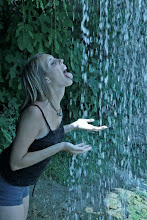Split people are proud, stubborn, and cynical. They sip their espressos, eyes twinkling through cigarette smoke. They smile when they think you're wrong. They talk, and talk, and talk; their voices get louder, and louder, and louder.
Their talk seldom turns into action. Splićani are energetic – by 9 a.m., the boardwalk is full with people strutting along the seaside. But they have an overarching laziness, which they call fiaka. Good idea, they say, we'll do it next week. Next week comes and goes. You insist, and they insist that you shouldn't worry. They talk some more, have another espresso, smoke another cigarette, tell another joke, and before you know it a month has passed without anything happening.
Splićani women are beautiful and deep-voiced. The men are strong and careless. Everyone has presence. They are tall, loud, and charming. They dress up to go to the market. Where does their confidence come from? In a big city, you can at least hope to be "seen" when you strut your stuff. In Split, everyone knows each other. They know that the rest of the world probably couldn't find them on a map. Their local ties are strong - most women are sporting wedding rings and pushing baby carriages before they're even 30. So why all the pomp and attitude?
I think Splićani's self-confidence is actually a product of their closed culture. Splićani don't travel much. What they see of the rest of the world comes from tourists. When you live in a bubble, it's easy to be confident. You're the most important thing in your world, because you're the only thing. I live in a city of kings and queens. I am somewhere between a curiosity and a guest.
Even within Split, the culture is divided into impenetrable spheres. Everyone has their "place." The gorgeous women go to the boardwalk. The smart kids go to the math school. The dumb, rich kids go to cooking school. The rebels go to Pancho's bar. If you roll your own cigarettes, you're a hobo. If you wear red shoes, you're gay. It's this reliance on categorization that allows Splićani to be so smug. The rich kids know they're rich, the gorgeous ladies know they're gorgeous, the smart kids know they're smart. Everyone criticizes each other, but everyone is proud of his own position.
I guess it follows naturally to ask whether or not a self-contained culture is a good thing. Turkish/French/American author Elif Shafak makes an interesting case that "if you want to destroy something in this life, be it acne, a blemish, or the human soul, all you need to do is surround it with thick walls. It will dry up inside." She claims that cultural cocoons are one of the greatest dangers in a globalized society. Stereotypes arise, compassion is weakened, and imagination is stifled.
Croatians scorn their corrupt government (the mayor of Split owns a major grocery store chain and gives all the top political jobs to his family members). They resent the lack of jobs. They scoff at the poor infrastructure in the country. They complain about the high cost of living. But they remain fiercely confident. They are happy. Maybe it's because they've set themselves low standards. Maybe it's because they prefer to laugh at their problems than struggle to change them. Maybe it's because they don't know any alternatives, except for the handful of people who still talk about the communist era with stars in their eyes. At least everyone had a job and a place to live, they say.
I'm a foreigner in Split. I agree with Shafak – it would be nice for the Split culture to be a bit more dynamic. But it's actually a selfish wish. I'm used to having more options – things like bowling alleys, live-model drawing groups, good cheap restaurants, and choirs. But who am I to say Split is "missing out"? Model drawing is not part of Split culture. If I made it available, they probably wouldn't use it. I have no right to burst their cultural bubble, especially if they're happy in it. The best I can do is make myself useful by catering to their needs. I'm also proud to have burst many stereotypes about Canadians and Americans. Do you know how many times I've been asked – seriously – whether Canadians are afraid of the dark?
I'm wary of volunteers with a holier-than-thou attitude. It's a mistake to believe that a good volunteer must have something "better" they think they can offer to a community. I think a good volunteer is more of a caterer than a revolutionary. Just go in with the best of what you've got, whether it be knowledge, a skill, or simply a good heart. Help someone, learn something, give something. Volunteering is a lesson in service and humility. Only once we've learned the lesson in humility can we break the barriers separating us from other individuals. And only once we've connected to other individuals can we connect to other cultures.
That was pretty cheesy, wasn't it. And kind of preachy. Sorry, still learning.
